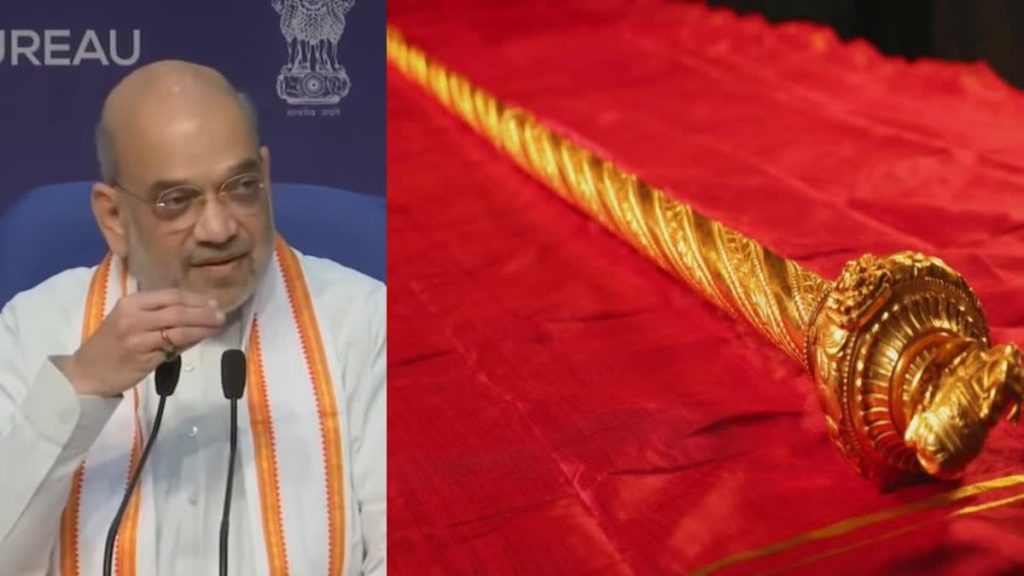New Delhi: As a major cultural symbol of India’s independence, a historic sceptre, ‘Sengol’, which marked the transfer of power from the Britishers in 1947, will be placed in the new Parliament building, Union Home Minister Amit Shah said on Wednesday.
‘Sengol’ is a symbol of historic legacy, which was used by former Prime Minister Jawaharlal Nehru on August 14, 1947, when the transfer of power took place from the British.
Addressing a press conference here, Amit Shah said, “On the occasion of Azadi ka Amrit Mahotsav, PM Modi will dedicate the new Parliament to the nation. In a way, it shows his far-sightedness. This is a beautiful attempt to merge our cultural legacy, tradition and civilisation with modernity. Around 60,000 people worked on the construction of this building in record time. The PM will also honour them.”
The Home Minister said that a historical event is being revived on this occasion. The historic sceptre, ‘Sengol’, will be placed in the new Parliament building.
“A historical event is being revived on this occasion. The historic sceptre, ‘Sengol’, will be placed in the new Parliament building. It was used on August 14, 1947, by PM Nehru when the transfer of power took place from the British. Out of all the promises made by PM Modi for ‘Azadi ka Amrit Mahotsav’, one promise was respect and regeneration of our historic traditions,” he said.
The Home Minister added, “The historic incident is from August 14, 1947. It is called Sengol in Tamil, the meaning of this word is full of wealth There is a tradition behind this associated with ages. Sengol had played an important role in our history. When PM Modi got information about this, a thorough investigation was done. Then it was decided that it should be put before the country. For this, the day of the inauguration of the new Parliament House was chosen.”
Recalling the historic event, the Home Minister said that ‘Sengol’ was chosen as the symbol of the transfer of power after intensive research.
“When the time for transfer of power came, Lord Mountbatten who was the Viceroy asked former PM Nehru about what should be the symbol of transfer of power to the country as per the Indian traditions. Nehru discussed the issue with freedom fighter and avid historic scholar C Rajagopalachari. He (Rajagopalachari) after doing an intensive historic research said that as per the Indian traditions, ‘Sengol’ has been marked as the symbol of historic transfer,” Shah said.
He added, “Based on this, Nehru accepted the Sengol from Adheenam, who were specially brought from Tamil Nadu. Thus, the power was transferred to the Indian hands. It is a realisation that the power came back to the Indians in a traditional method. Nehru accepted the ‘Sengol’ in the presence Dr Rajendra Prasad and many others. Nehru’s aim was emotional unity and academic integration. The event was widely reported in media and even in foreign countries.”
According to historical accounts, C Rajagopalachari had approached the Dharmic Mutt in the Tanjore district of Tamil Nadu – the Thiruvavaduthurai Adheenam. The leader of the Adheenam immediately commissioned the preparation of the ‘Sengol’.
What is Sengol
The word Sengol is derived from the Tamil word ‘Semmai’, meaning ‘Righteousness’. It is an Indic civilizational practice from the Chola kingdom, which was among the leading kingdoms in the Indian sub-continent for centuries.
As per the historic tradition, at the time of enthronement, the traditional guru of the preceptor of the King would hand over the ceremonial Scepter to the new ruler.
At the time of the power transfer on August 14, 1947, three people were specially flown in from Tamil Nadu on August 14, 1947 – the Deputy high priest of the Adheenam, the Nadaswaram player Rajarathinam Pillai and the Oduvar (singer) – carrying the Sengol.
The priests conducted the proceedings. They gave the Sengol to Lord Mountbatten and took it back. The Sengol was purified with holy water. It was then taken in procession to Pandit Jawaharlal Nehru’s house, where it was handed over to him. A special song was rendered, as specified by the high priest.

